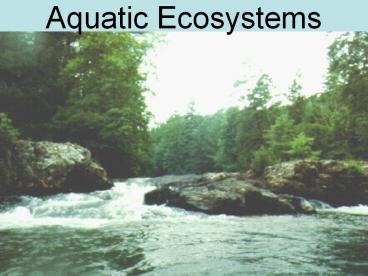Aquatic Ecosystems - PowerPoint PPT Presentation
Title:
Aquatic Ecosystems
Description:
Title: Aquatic Ecosystems Author: E200101610 Last modified by: E200100576 Created Date: 9/13/2006 11:24:52 PM Document presentation format: On-screen Show (4:3) – PowerPoint PPT presentation
Number of Views:533
Avg rating:3.0/5.0
Title: Aquatic Ecosystems
1
Aquatic Ecosystems
2
4 things determine aquatic ecosystems
- Depth
- Flow
- Temperature
- Chemistry
3
- Only 3 of the Earths surface is fresh water.
4
Two types of freshwater ecosystems
5
Flowing water ecosystems
6
Standing water ecosystems
7
Flowing Water Ecosystems
- Rivers
- Streams
- Creeks
- Brooks
8
Animals that live in Flowing Water ecosystems
9
Catfish
10
Trout
11
Turtles
12
Beavers
13
River Otters
14
Standing Water Ecosystems
- Lakes
- ponds
15
Plankton
- General term for the tiny, free-floating or
weakly swimming organisms that live in both fresh
and salt water environments. - Phytoplankton single celled photosynthetic
algae - Zooplankton small animals, usually microscopic,
that feed on the phytoplankton.
16
Wetlands
- Wetlands are productive because they are shallow
with a lot of organic plant matter in the water
that serves as breeding grounds for insects,
fishes and other aquatic animals, amphibians, and
migratory birds.
17
Wetland Bogs
- Form in depressions left by sheets of ice.
- Thick mats of sphagnum moss grow and the bogs
tend to be very acidic.
18
Bog Finds
- Many ancient bodies are preserved in the acidic /
oxygen free bogs. - This man found in
- 1950 is estimated to
- be over 2000 years
- old.
19
Venus Flytrap
- Pitcher Plants
20
Wetland Marshes are shallow wetlands along
streams that remain wet at least half the year.
21
Sawgrass marsh in the Everglades
22
Wetland Swamps
- Wet year round
- Often look like flooded forests with trees and
shrubs.
23
Okefenokee Swamp
24
- Estuaries are wetlands formed where rivers meet
the sea. - They contain a mixture of fresh and salt water.
25
Estuaries
- Freshwater and saltwater mix - brackish
26
Estuary Examples
- Salt marshes temperate zone estuaries dominated
by salt-tolerant grasses above the low tide line,
and by seagrasses under water. - Mangrove swamps are coastal wetlands that are
widespread across tropical regions, including
southern Florida and Hawaii.
27
(No Transcript)
28
Salt Marsh
29
Marine Ecosystems
- Contain salt water
- Photic zone well lit upper layer down to 200
meters where algae and other producers can grow. - Aphotic zone permanently dark area where no
photosynthetic organisms live, but some
chemosynthetic organisms live.
30
Marine zone based on depth of water distance
from shore
- Intertidal zone
- Coastal ocean
- Open ocean
31
(No Transcript)
32
Tides
- The portion of the shoreline that lies between
the high and low tide lines is called the
intertidal zone.
33
Intertidal zone
- Barnacles
- Seaweed
- Snails
- Sea urchins
- Sea stars
34
- Intertidal Zone
35
Coastal ocean
- Kelp forests
- Snails
- Sea urchins
- Sea otters
- Fishes
- Seals
- whales
36
Coral Reefs
- Corals are relatives to the jellyfish that
secrete a hard substance called calcium
carbonate. - They live in symbiosis with algae contained
within the body of each coral animal. - Almost all grow within 40 meters of the surface.
37
Coral Reefs
38
Open Ocean
- Begins at the edge
- of the continental
- shelf and extends
- outward.
- Largest marine zone
- 500 meters to 11,000 meters.
- Swordfish, octopus, dolphins, whales
39
Plankton
- Small organisms that live in the waters of the
photic zone. - phytoplanktonmicroscopic plants and bacteria
- zooplanktonmicroscopic animals
40
Benthic Zone
- Ocean floor
- Organisms that live near or attached to the
bottom - Sea stars, anemones, marine worms all referred
to as benthos. - Clams, sea cucumbers
41
- Harris Neck NWR
42
- Baby Alligator
43
- Sapelo Island
44
- Sapelo Island - Blackbeard































